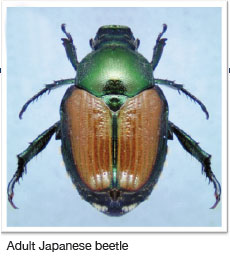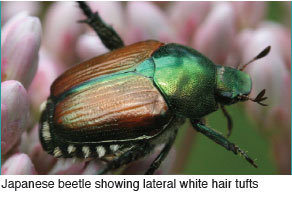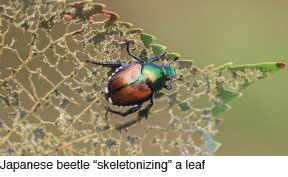Japanese beetle (Popillia japonica) - Fact Sheet
Why is it regulated?
Japanese beetle, Popillia japonica, is an invasive plant pest that was first introduced to eastern North America from Japan in 1916. The adults are active flyers, but natural spread is slow and they are not able to travel long distances on their own. These beetles may move long distances as hitchhikers on plant material, in roots or soil, or even on cars, trains or planes. The Canadian Food Inspection Agency (CFIA) is working with its partners to minimize the human assisted spread of this insect to new areas.

What does it look like?

Adult Japanese beetles are oval-shaped and approximately 1 cm long. They are metallic green with two bronze wing covers and six white tufts of hair on each side of the abdomen. The larvae look very similar to chafer beetle and other creamy white C-shaped grubs that are found in the soil.
What does it eat?

Japanese beetle larvae feed on the roots of turf grass and other plants. Adults are heavy feeders, attacking the flowers, foliage and fruit of more than 250 plant species, including roses, blueberries and grapevines.
What are the impacts?
Adult Japanese beetles skeletonize leaves and eat flowers and fruit. They can significantly damage landscape plants, ornamental plants, fruit and vegetable gardens, nurseries, orchards, and agricultural crops. The larvae feed on the roots of turf and other plants and can seriously damage lawns, sports fields, golf courses and turf production.
Where is it now?
Japanese beetle is present throughout most of eastern North America. The CFIA places traps across southern British Columbia each summer as part of a surveillance network to alert the CFIA of any new introductions of the beetle. Each trap includes a pheromone and a plant volatile lure to attract the insect. Japanese beetle was detected in British Columbia for the first time in 2017. Adult Japanese beetles were found in CFIA traps placed around False Creek in Vancouver.
How can I help?
- Report any insects that you suspect could be Japanese beetle to the CFIA by calling 1-800-442-2342.
- Do not move or tamper with any of the Japanese beetle traps that you see this summer.
- Avoid moving soil, plants with soil, pruning waste and other plant debris from areas where this insect has been reported.
Questions?
Visit our website for more information: inspection.gc.ca/jb
Photo credits: J. Baker, D. Cappaert, S. Katovich (Bugwood.org), CFIA
- Date modified: